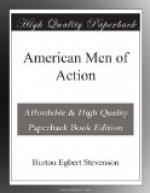There he learned that he need not have fled from Pennsylvania, that the man with whom he had fought years before was not dead, but had recovered. For the first time since his appearance in the west, he assumed his real name, and was known thereafter as Simon Kenton. Soon afterwards he returned to his old home, and brought the whole family back with him to Kentucky. One would have thought he had had enough of fighting, but he was with Wayne at the Fallen timbers and with William Henry Harrison at the battle of the Thames. Sadly enough, the last years of this old hero were passed in want. His land in Kentucky was taken from him by speculators because he had failed to have it properly registered, and he was imprisoned for debt on the spot where he had reared the first cabin in northern Kentucky.
In the spring of 1824, an old, tattered, weather-beaten figure appeared on the streets of Frankfort, the capital of Kentucky. So strange and wild it was that a gang of street boys gathered and ran hooting after it. Men laughed—till suddenly, one of them, looking again, recognized Simon Kenton. In a moment a guard of honor was formed, and the tattered figure was conducted to the Capitol, placed in the speaker’s chair, and for the first and only time in his life, Simon Kenton received some portion of the respect and homage to which his deeds entitled him.
* * * * *
Boone and Kenton, with a handful of hardy and fearless pioneers, laid the foundations of Kentucky; but in the history of the “Old Northwest,” the country north of the Ohio and east of the Mississippi, one name stands out transcendent; the name of a man as daring, as brave, as resourceful as any on the border—George Rogers Clark. He was greater than Boone or Kenton in that he had a wider vision; they saw only the duties of the present; he saw the possibilities of the future, and his exploits form one of the most thrilling chapters of American history.
Clark, a Virginian by birth, started out in life as a surveyor, and early in 1775, removed to Kentucky to follow his profession. There was, no doubt, plenty of surveying to be done there, since the whole country was an uncharted wilderness, but the beginning of the Revolution was accompanied by an immediate outbreak of Indian hostilities, so serious that the very existence of the Kentucky settlements was threatened. Soon all but two of them, Boonesborough and Harrodsburg, had to be abandoned. Boone was, of course, in command at his fort, and Clark, who had seen some service in Dunmore’s war, became the natural leader at Harrod’s. His influence rapidly increased, and he was chosen as a delegate to journey to Williamsburg and urge upon Virginia the needs of the western colony, which lay within her chartered limits.




